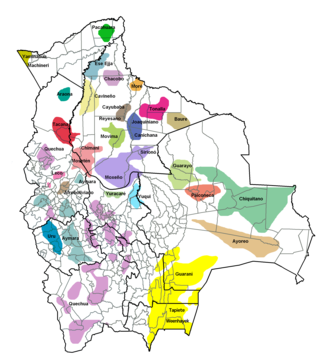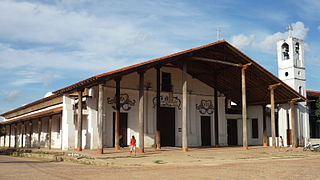Moxo may refer to:
Britain most often refers to:
Spanish might refer to:
Bengali or Bengalee, or Bengalese may refer to:
Moxos may refer to:
San Ignacio is a common toponym in parts of the world where that language is or was spoken:

Trinidad, officially La Santísima Trinidad, is a city in Bolivia, capital of the department of Beni. The population is 130,000. While historically a peripheral city in Bolivia, Trinidad is today an important center for the Bolivian Bovine industry and has enjoyed a modest economic boom in recent years and enjoys an HDI index of above 0.700.
Mojo may refer to:
Moxos is a province in the Beni Department, Bolivia. It is named after the Moxos savanna.
Mocho may refer to:
Bauré is an endangered Arawakan language spoken by only 40 of the thousand Baure people of the Beni Department of northwest of Magdalena, Bolivia. Some Bible portions have been translated into Bauré. Most speakers have been shifting to Spanish.

The Mojeños, also known as Moxeños, Moxos, or Mojos, are an indigenous people of Bolivia. They live in south central Beni Department, on both banks of the Mamore River, and on the marshy plains to its west, known as the Llanos de Mojos. The Mamore is a tributary to the Madeira River in northern Bolivia.

Canichana, or Canesi, Joaquiniano, is a possible language isolate of Bolivia. In 1991 there were 500 Canichana people, but only 20 spoke the Canichana language; by 2000 the ethnic population was 583, but the language had no L1 speakers left.
Loreto is a smalI municipality in the Beni Department in northern Bolivia, capital of the Marbán Province and Loreto Municipality. In 2001, Loreto had a population of 843.

San Ignacio de Moxos is a town in the Beni Department of northern Bolivia.

Movima is a language that is spoken by about 1,400 of the Movima, a group of Native Americans that resides in the Llanos de Moxos region of the Bolivian Amazon, in northeastern Bolivia. It is considered a language isolate, as it has not been proven to be related to any other language.
Moxo is any of the Arawakan languages spoken by the Moxo people of the Llanos de Moxos in northeastern Bolivia. The two extant languages of the Moxo people, Trinitario and Ignaciano, are as distinct from one another as they are from neighboring Arawakan languages. The extinct Magiana was also distinct.

San Joaquín is a small agricultural town in the Beni Department in the Bolivian lowlands.
Chiriba (Chiriva) is a poorly attested language of Moxos Province, Bolivia which may have belonged to the Panoan family. All that was recorded of it was a list of seven words; several of these resemble Panoan languages, especially Pakawara, and none resemble other language families. Unattested Chumana is reported to have been related.

The Llanos de Moxos also known as the Moxos plains are extensive remains of pre-Columbian agricultural societies scattered over the Moxos plains in most of Beni Department, Bolivia. The remains testify to a well-organized and numerous indigenous people. This contradicts the traditional view of archaeologists, notably Betty Meggers, who asserted that the Amazon River Basin was not environmentally able to sustain a large population and that its indigenous inhabitants were hunter-gatherer bands or slash-and-burn farmers. In the 1960s, petroleum company geologists and geographer William Denevan were among the first to publicize the existence of extensive prehistoric earthworks constructed in the Amazon, especially in the Llanos de Moxos.

The Jesuit Missions of Moxos are located in the Llanos de Moxos of Beni department in eastern Bolivia. Distinguished by a unique fusion of European and Amerindian cultural influences, the missions were founded as reductions or reducciones de indios by Jesuits in the 17th and 18th centuries to convert local tribes to Christianity.